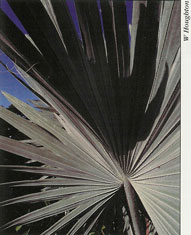Smart Palm Fertilizing
Katherine Maidman, Former Curator of Palms
 |
| A healthy Gastrococcos crispa |
Here is a simple guide to effective maintenance feeding of your landscape palms. Product and application information are based on the latest recommendations from the University of Florida's Cooperative Extension Institute of Food and Agricultural Services, where research continues to fine tune palm growing in our South Florida conditions.
Do I need to fertilize all my landscape palms?
For the many palms affected by deficiencies in South Florida's nutrient poor soils, fertilizing is a necessity. While certain palms, native species for instance, can grow well in our landscapes with no fertilizing, all palms benefit rom regular maintenance feeding, which will show in their overall appearance and rate of growth. By keeping plants strong, fertilizing boosts their resistance to pest and disease problems.
What is a good program of “maintenance feeding”?
By maintenance feeding, we mean regular fertilizing of all your palms with a balanced, complete fertilizer to maintain health, and vigor. Done right, this can often prevent the common nutrient deficiencies of potassium (K), manganese (Mn), and magnesium (Mg), which take a lot of time and effort to correct once they cause symptoms. A widely recommended maintenance feeding program for your landscape palms is the use of a balanced, complete, granular fertilizer formulated for palms. Such fertilizers are widely called ‘Palm Special’ fertilizers. There are a number of companies supplying these mixes in South Florida.
What do I look for in a palm special fertilizer?
The best palm special fertilizers have evolved in light of new recommendations from palm nutrition expert Dr. Timothy Broschat of the University of Florida. They have been improved based on extensive testing in the South Florida landscape. Here is what your fertilizer needs to be effective:
- Look for formula 8-4-12 fertilizer, or as close to this nitrogen-phosphorus-potassium (N-P-K) ratio as possible. In addition check for Magnesium. Total Magnesium (as Mg) should be close to or equal 4% when included in the 8-4-12 formula.
- Both N and K should be in a 100% controlled release form. K deficiency is the most common palm nutrient deficiency in South Florida, due to the high solubility of this element and poor nutrient holding capacity of the soils. The higher level of K now recommended, along with the 100% controlled release form, can help prevent K deficiency. The controlled release form also helps prevent groundwater contamination from rapid leaching of K through our soils.
- Micronutrients should be in sulfate form. The oxide form of some fertilizers use renders these nutrients unavailable in our alkaline soils. On the label, under “derived from” or “nutrient sources” look for: iron sulfate, manganese sulfate, copper sulfate, or zinc sulfate.
 |
| Careful feeding brings out the beauty of palms. |
How should palm special fertilizer be applied?
You should distribute fertilizer over the majority of the root system, which extends roughly from the trunk out to the edge of the canopy. Broadcast fertilizer as evenly as possible on the ground in this area. Think of it as an even sprinkling of salt. Any heaps, or the common ring of fertilizer around the palm, will burn and kill the roots directly beneath. Avoid getting fertilizer on the base of the stem, in the leaf bases or crown for the same reason.
When and how should I fertilize?
The useful life of most palm special fertilizers is two to three months. A suggested rate is three to four pounds per medium size adult palm every three months. Adjust this rate according to plant size. Fertilizer nutrients are released by irrigation water or rain; bear this in mind in your yearly schedule, as well as the fact that less is taken up by plants at the coldest time of the year. We recommend fertilizing in the following months: late March, June, September and late October. Try to fertilize at least three times a year.
Could a palm special fertilizer be used on other plants?
Yes, palm special fertilizer is the right formula for most landscape plants in South Florida. It is used for maintenance feeding of most outdoor collections at Fairchild.
Garden Views May 2001